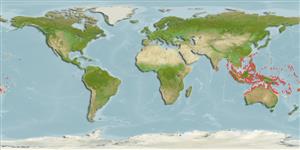Environment: milieu / climate zone / depth range / distribution range
Ecology
Marine; reef-associated; depth range 1 - 20 m (Ref. 90102). Tropical; 27°N - 27°S, 28°E - 133°W (Ref. 74933)
Indo-Pacific: known from the Red Sea, Indian Ocean (except the Seychelles, Chagos Archipelago, Cargados Carajos, Mauritius and Rodrigues), north to Japan and south to Australia; throughout the West Pacific to the Tonga Islands, Samoa, Phoenix and Marshall Islands.
Size / Weight / Age
Maturity: Lm ? range ? - ? cm
Max length : 11.2 cm TL male/unsexed; (Ref. 90102)
Short description
Morphology | Morphometrics
Common in reef flats and shallow lagoons, but hiding by day within Acropora thickets and other corals, as well as in holes and crevices and emerging at night to forage on free-swimming invertebrates (Ref. 1602). Also found in sheltered seaward slopes in 1-20 m (Ref 90102). Feeds on small fishes and benthic invertebrates (e.g. shrimps - alpheids and penaieds; isopods, copepods, crab larvae, polychaete worms); relatively close to cover, within about 1-2 m (Ref. 11890).
Life cycle and mating behavior
Maturity | Reproduction | Spawning | Eggs | Fecundity | Larvae
Mouthbrooders (Ref. 240). Distinct pairing during courtship and spawning (Ref. 205).
Nakabo, T., 2002. Fishes of Japan with pictorial keys to the species, English edition I. Tokai University Press, Japan, pp v-866. (Ref. 41299)
IUCN Red List Status (Ref. 130435)
Threat to humans
Harmless
Human uses
More information
ReferencesAquacultureAquaculture profileStrainsGeneticsElectrophoresesHeritabilityDiseasesProcessingNutrientsMass conversion
Tools
Special reports
Download XML
Internet sources
Estimates based on models
Preferred temperature (Ref.
123201): 25.7 - 29.3, mean 28.7 °C (based on 2182 cells).
Phylogenetic diversity index (Ref.
82804): PD
50 = 0.5020 [Uniqueness, from 0.5 = low to 2.0 = high].
Bayesian length-weight: a=0.01698 (0.01020 - 0.02828), b=2.97 (2.83 - 3.11), in cm total length, based on LWR estimates for this species & (Sub)family-body (Ref.
93245).
Trophic level (Ref.
69278): 3.3 ±0.2 se; based on diet studies.
Resilience (Ref.
120179): High, minimum population doubling time less than 15 months (Preliminary K or Fecundity.).
Fishing Vulnerability (Ref.
59153): Low vulnerability (10 of 100).
Nutrients (Ref.
124155): Calcium = 138 [71, 220] mg/100g; Iron = 0.953 [0.557, 1.629] mg/100g; Protein = 18.6 [17.4, 19.8] %; Omega3 = 0.12 [0.07, 0.20] g/100g; Selenium = 28.6 [15.1, 55.2] μg/100g; VitaminA = 55.8 [16.2, 190.5] μg/100g; Zinc = 1.69 [1.11, 2.49] mg/100g (wet weight);
